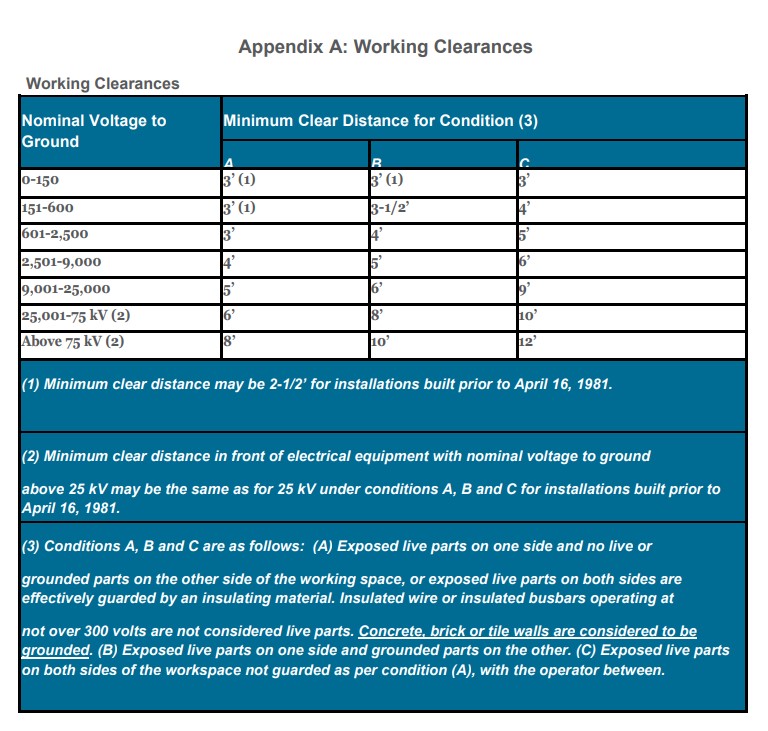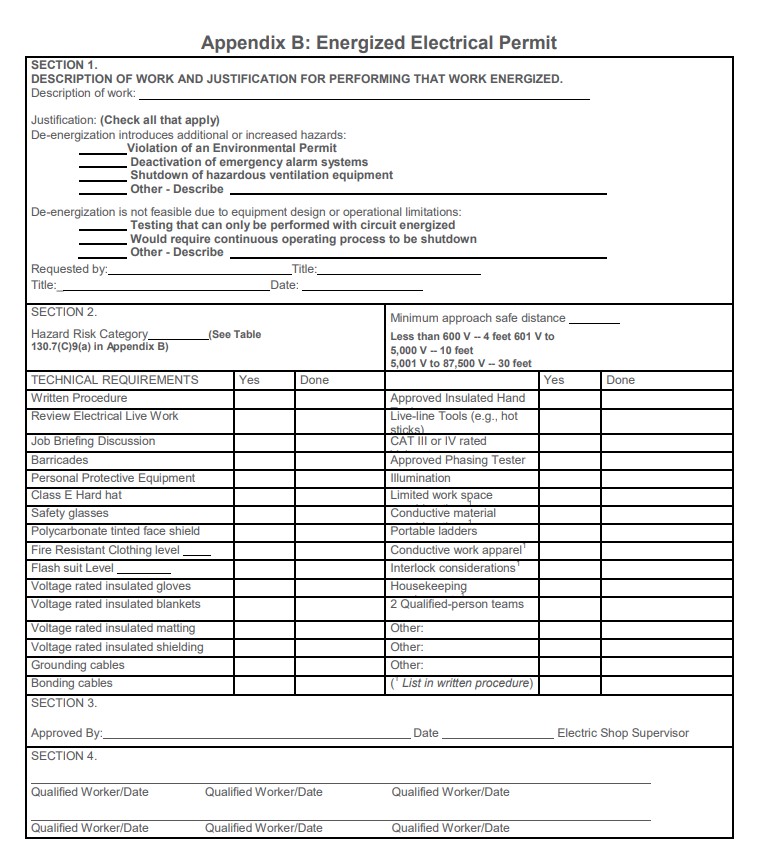Environmental Health & Safety
Electrical Safety UTK Environmental Health & Safety Guide GS-070
This document serves as a guide to relevant regulatory requirements related to electrical installation and workplace safety.
Effective Date: 08/01/2009
Revision Date: 03/14/2012
Purpose
This document serves as a guide to relevant regulatory requirement related to electrical workplace safety. The goal is to ensure that UTK employees understand and comply with the regulatory requirements of OSHA’s electrical standard (29 CFR 1910. Subpart S) and to protect all students, staff, faculty, and visitors on the UTK campus.
Scope and Applicability
This document applies to any employees working on or near wiring, installing electrical conductors and equipment, as well as installation of optical fiber cable near or with electrical wiring.
Abbreviations and Definitions
Abbreviations
GFCI-Ground Fault Circuit Interrupter
OSHA-Occupational Safety and Health Administration
NFPA-National Fire Prevention Association
Definitions
GFCI: A device intended for the protection of personnel that monitors the amount of current flowing from the hot conductor to neutral conductor and interrupts the circuit if there is an imbalance of more than 4-5 milliamps.
Lockout/Tagout (LOTO): refers to specific practices and procedures to safeguard employees from the unexpected energization or startup of machinery and equipment, or the release of hazardous energy during service or maintenance.
Qualified person: One who has the skills and knowledge related to the construction and operation of the electrical equipment and installations and has received safety training on the hazards involved.
Unqualified persons: People with little or no such training related to electrical equipment and safety.
Roles and Responsibilities
Supervisors shall:
- Anticipate all work hazards and utilize all safeguards as necessary.
- Ensure that all employees are properly trained, instructed in the safe operation of electrical equipment and are aware of all hazards associated with the use of these electrical devices.
- Initiate any necessary administrative action required to enforce safety practices.
- Request assistance from Facilities Services on equipment and devices, which requires unique safety practice instruction.
- Review qualified employees to ensure they are capable of handling their specific job duties.
Employees shall:
- Follow UTK’s electrical safety policies/procedures and instructions of the responsible supervisor.
- Bring to the attention of the supervisor and/or EHS potentially hazardous situations such as discrepancies between instruction, procedures, policies and manual, faulty equipment, misapplication of device, etc.
- Recognize that malfunctioning electrical equipment must be repaired or replaced before use. The repair must be initiated as soon as possible after the malfunction is noted.
EHS shall:
- Provide technical assistance in defining hazardous operations, designating safe practices and selecting proper devices.
- When necessary, recommend the development of standard operating procedure for electrical equipment and devices in use from the principal supervisor.
- In coordination with Facilities Services and other supervisors, review and approve standard operating procedures upon request.
- Evaluate potential electrical hazards during facility inspections to insure compliance with existing policy and other safety guidelines.
- Request support on hardware and equipment testing, tagging out of service equipment, and taking corrective action where necessary.
- Support employees training relative to electrical safety.
- Develop and revise UTK’s electrical safety policy periodically, or when regulatory changes occur.
Qualified Persons shall:
- Comply with UTK’s electrical safety program and take all required training.
- Be designated as the only people allowed to work on or near exposed electrical parts >50 volts.
- Be designated as the only people who can test exposed electrical currents and equipment.
- Test equipment for damages and defects before use.
- Must be trained on how to work on energized currents, be familiar with proper precautionary work practices, personal protective equipment, insulating and shielding materials, and the use of insulated tools.
Procedures
The following practices are to be followed by all employees:
A. Electrical Installation Requirements
- Free from Recognized Hazards – Electrical equipment must be free from recognized hazards that are likely to cause death or serious physical harm. Equipment must be suitable for the installation and use, and must be installed and used in accordance with the National Electrical Code (NEC) and/or Occupational Safety and Health Administration (OSHA).
- Labeling of Disconnects -Each disconnecting means, must be clearly labeled to indicate the circuit’s function unless it is located and arranged so the purpose is evident. Identification should be specific rather than general and all labels and marking must be durable enough to withstand the environment to which they may be exposed and must include nominal voltage being utilized by the device.
- Energy from more than one source – motors and motor operated equipment with more than one source of power may have multiple disconnects. Where multiple disconnecting means are provided, a permanent warning sign shall be provided on or adjacent to each disconnecting means.
- Guarding of Live Parts – Live parts of electric equipment operating at 50 volts or more must be guarded by use of an approved cabinet or in a room or vault that is accessible to qualified persons only.
- Warning Signage – Entrances to rooms and other guarded locations that contain exposed live parts operating at 50 volts or more shall be marked with conspicuous warning signs forbidding unqualified persons to enter.
B. General Wiring Design and Protection
- New electrical wiring, and the modification, extension or replacement of existing wiring must conform to the requirements of NEC, the National Fire Protection Association (NFPA), OSHA and the following:
- No grounded conductor may be attached to any terminal or lead so as to reverse designated polarity.
- The grounding terminal or grounding-type device on receptacles, cord connector, or attachment plug may not be used for any purpose other than grounding.
- Conductors and equipment must be protected from overcurrent above their listed current carrying capacity.
- All alternating current systems of 50 to 1,000 volts must normally be grounded as required by the NEC and OSHA. The path to ground from circuits, equipment and enclosures must be permanent and continuous.
- Conductors entering boxes, cabinets or fittings must be protected from abrasion, and openings through which conductors enter must be effectively closed.
- All pull boxes, junction boxes and fittings must be provided with covers approved for the purpose. If metal covers are used they must be grounded. In completed installations, each outlet box must have a cover, faceplate or fixture canopy. Pull boxes and junction boxes for systems over 600 volts, nominal, must provide complete enclosure, the boxes must be closed by suitable covers securely fastened in place, and the cover must be permanently marked “High Voltage.”
- Switchboards and panelboards that have exposed live parts must be located in permanently dry locations and accessible to qualified persons only. Panelboards must be mounted in cabinets, cutout boxes or other approved enclosures, and must be dead front unless accessible to qualified persons only. Receptacles installed in damp or wet locations must be suitable for the location
- Cabinets, cutout boxes, fittings, boxes and panel board enclosures in damp or wet locations must be installed to prevent moisture or water from entering and accumulating within the enclosure. In wet locations the enclosures must be weatherproof.
- Fixtures, lamp holders, lamps, rosettes, and receptacles may have no live parts normally exposed to employee contact.
- Screw-base light socket adapters do not maintain ground continuity and may not be used.
- Multi-plug receptacle adapters may not maintain ground continuity or may overload circuits and must not be used. If additional receptacles are needed in a work location, additional circuits and/or receptacles must be installed.
- Multi-plug power strips with overcurrent protection are acceptable for use with electronic equipment, however, they may not be “daisy-chained” (i.e., two or more power strips plugged into each other in a chain).
- Electrical equipment, wiring methods and installations of equipment in hazardous classified locations must be intrinsically safe, approved for the location, or safe for the location.
C. Requirements for Temporary Wiring
Temporary electrical power and lighting installations 600 volts or less, including flexible cords, cables, extension cords and distribution panels, may only be used during and for renovation, maintenance, repair, or experimental work. Temporary wiring may also be used for decorative lighting for special events and similar purposes for a period not to exceed 90 days. The following additional requirements apply:
- Ground-fault protection (e.g., ground-fault circuit interrupters or GFCI) must be provided on all temporary-wiring circuits, including extension cords, used on construction sites. A GFCI must also be used when extension cords and/or equipment are used in wet, damp or conductive locations.
- In general, all equipment and tools connected by cord and plug must be grounded. Listed or labeled double insulated tools and appliances need not be grounded.
- Feeders must originate in an approved distribution center, such as a panel board, that is rated for the voltages and currents the system is expected to carry.
- Branch circuits must originate in an approved power outlet or panel board.
- Bare conductors or earth returns shall not be used for the wiring of any temporary circuit.
- Receptacles must be of the grounding type. Unless installed in a complete metallic raceway, each branch circuit must contain a separate equipment- grounding conductor, and all receptacles must be electrically connected to the grounding conductor.
- Flexible cords and cables must be UL listed and suitable for the location and intended use.
- Flexible cords may not be:
- run through holes in walls,
- ceilings or floors,
- run through doorways,
- windows or similar pinch points unless protected from damage;
- attached to building surfaces,
- concealed behind building walls,
- ceilings or floors,
- or used as a substitute for fixed wiring.
- Flexible cords and cables must be protected from accidental damage. Sharp corners and projections are to be avoided.
- Temporary wiring, such as extension cords, should be inspected before each use. Splicing is prohibited.
D. Open Conductors, Clearance from Ground
Open conductors must be located at least 10 feet above any finished grade, sidewalk or projection; 12 feet above areas subject to non-truck traffic; 15 feet above areas subject to truck traffic; and 18 feet above public streets, roads or driveways.
E. Entrances and Access to Workspace
In any workspace where there is electric equipment operating at over 600 volts, there must be at least one entrance at least 24” wide and 6’-6” high to permit escape in the event of an emergency. Any exposed energized conductors operating at any voltage and located near the entrance must be guarded to prevent accidental contact. Any insulated energized conductors operating at over 600 volts and located next to the entrance must also be guarded.
F. Working Space about Electric Equipment
Sufficient access and working space must be provided and maintained around all electric equipment to permit ready and safe operation and maintenance of the equipment. Working clearances may not be less than 36 inches in front of electric equipment. Except as permitted by OSHA or the NEC, the working space in front of live parts operating at 600 volts or less that requires servicing, inspection or maintenance while energized may not be less than indicated in Table 1 in Appendix A. This working space shall not be used for storage.
G. Working on Electrical Systems – Energized Parts
Live parts to which an employee may be exposed will be de-energized, using approved lockout/tagout procedures, before the employee works on or near them, unless:
- Work is performed on or near live parts by qualified persons related to tasks such as testing, trouble- shooting, voltage measuring, etc., provided appropriate safe work practices and personal protective equipment are used or, the live parts operate at less than 50 volts to ground and there is no increased exposure to electrical burns or to explosion due to electric arcs.
- De-energizing introduces “additional or increased hazards.” (i.e. shutdown of critical fume hood ventilation systems);
- De-energizing is not possible due to equipment design or operational limitations.
Except for emergency repairs to the extent necessary to safeguard the general public, at least two qualified persons shall be present during:
- installation, removal, or repair of lines that are energized at more than 600 volts;
- installation, removal, or repair of de-energized lines if an employee is exposed to contact with other parts energized at more than 600 volts; or
- installation, removal, or repair of transformers, capacitors, regulators, switch gear or other mechanical equipment, if an employee is exposed to contact with parts energized at more than 600 volts.
Always have an observer trained in emergency shutdown and first aid. Follow the one hand rule when working on live circuits, if possible. When employees work on exposed de-energized parts or near enough to them to expose the employee to an electrical hazard, then the following safety related work practices will be followed:
- Any conductors or parts of electric equipment that have not been properly locked and/or tagged out must be treated as energized even if these systems have been de-energized.
- If the potential exists for an employee to contact parts of fixed electric equipment or circuits that have been de-energized, the circuits energizing the parts must be locked and tagged out.
De-energizing Equipment: Safe procedures for de-energizing circuits and equipment will be determined by a qualified person before the circuit or equipment is de-energized.
- Circuits and equipment to be worked on will be disconnected by the worker from all electric energy sources.
- Stored electrical energy that might endanger personnel must be safely released prior to the work.
- Stored non-electrical energy (e.g., hydraulic or pneumatic) in devices that could reenergize electric circuit parts must be blocked or relieved so that circuit parts cannot be accidentally reenergized by the device.
- A lock and tag must be placed on each disconnecting means used to de- energize circuits and equipment on which work is to be done.
Verification of De-energized Condition: The following requirements must be met before any circuit or equipment is considered de-energized or may be worked on as de-energized.
- A qualified person must activate the equipment operating controls or use other methods to verify that the equipment cannot be restarted.
- A qualified person must use test equipment to ensure that electrical parts and circuit elements are de-energized. The test must confirm there is no energized condition from induced voltage or voltage backfeed.
- Test equipment and instruments must be visually inspected for external defects or damage before being used to verify that the equipment or circuit is de-energized.
- When voltage over 600 volts nominal is tested, the test equipment must be checked for proper operation immediately before and after the test on a known live source.
Re-energizing Equipment:
The following requirements must be met, in the order given, before circuits or equipment is reenergized, even temporarily:
- If electrical jumpers, shorts, grounds or other such devices have been used as part of a lockout/tagout, a qualified person must conduct tests and visual inspections as necessary to verify that all electrical jumpers, shorts, grounds and other such devices have been removed so that circuits and equipment can be safely energized;
- Employees potentially exposed to the hazards of re-energizing the circuit must be warned to stay clear; and each employee removes his or her own lock(s) and tag(s).
H. Overhead Power Lines
When work is to be performed near overhead lines, the lines must be de- energized and grounded whenever possible. If it is not possible to de-energize and ground overhead lines, then other protective measures, such as guarding, isolating or insulating, must be taken before the work is started. These protective measures must prevent direct contact by the qualified person or indirect contact through conductive materials, tools, or equipment. Only qualified persons are allowed to install insulating devices on overhead power transmission and distribution lines. All other persons, and any conductive object used by these employees, may not approach closer than the minimum approach distance of 10 feet when the voltage to ground is 50 kV or less, and 10 ft. + 4 inches for every 10 kV over 50 kV when the voltage to ground is >50 kV.
Qualified persons working in the vicinity of energized overhead lines, whether in an elevated position or on the ground, are not allowed to approach any exposed energized parts closer than allowed in the table below unless:
- The person is insulated from the energized part by using voltage rated gloves, (with sleeves and or hot stick if necessary); or
- The energized part is insulated from all other conductive objects at a different potential and from the person; or
- The person is insulated from all conductive objects that are at a potential different from the energized part.
Approach Distances for Qualified Persons Exposed to Alternating Current (OSHA 1910.333 Table S-5) | |
Voltage Range (phase-to- phase) | Minimum Approach Distance |
300 V and less | Avoid contact |
Over 300 V, not over 750 V | 1 ft. 0 in. |
Over 750 V, not over 2 kV | 1 ft. 6 in. |
Over 2 kV, not over 15 kV | 2 ft. 0 in. |
Over 15 kV, not over 37 kV | 3 ft. 0 in. |
Over 37 kV, no over 87.5 kV | 3 ft. 6 in. |
Over 87.5 kV, not over 121 kV | 4 ft. 0 in. |
Over 121 kV, not over 140 kV | 4 ft. 6 in. |
I. Vehicles and Mechanical Equipment
- A minimum clearance of 10 feet must be maintained between energized overhead lines and all vehicles or mechanical equipment capable of having parts or its structure elevated (e.g., cranes, mobile scaffolds, elevating platforms, dump trucks, lift trucks, and flatbed trailer cranes). If the voltage of the overhead line is greater than 50 kV, the clearance must be increased by 4 inches for every 10 kV over 50 kV. 6.1 The clearance requirement may be reduced if the vehicle is in transit with its structure lowered. The clearance may be reduced to 4 feet when near energized lines operating at less than 50 kV, or 4 ft. plus 4 inches for every 10 kV over 50 kV.
- The clearance requirement may be reduced if insulating barriers, rated for the voltage of the line being guarded, are installed to prevent contact with the lines. The barrier may not be attached to the vehicle or its raised structure. The clearance may be reduced to the distance allowed by the design of the insulating barrier.
- The clearance requirement may be reduced if the equipment is an aerial lift insulated for the voltage involved and the work is performed by a qualified person. The clearance between the uninsulated portion of the lift and the power line may be reduced to the distance given in Table 2 above.
- Persons working on the ground are not allowed to contact the vehicle or mechanical equipment or any of its attachments, unless:
o The person uses protective equipment rated for the voltage; or
- The equipment is located so that no uninsulated part of its structure can provide a conductive path to persons on the ground. Equipment shall not approach closer to the line than 10 feet for voltages less than 50 kV, or 10 feet plus 4 inches for every 10 kV over 50 kV.
- When any vehicle or mechanical equipment is intentionally grounded, persons may not stand near the point of grounding when there is any possibility of contact with overhead energized lines. Additional precautions (e.g., such as the use of barricades or insulation) must be taken as necessary to protect persons from hazardous ground potentials that can develop within a few feet or more outward from the grounding point.
- Unqualified persons shall stay beyond the next utility pole in either direction as a minimum.
- Qualified persons on the ground shall establish boundaries (i.e., plastic red barrier tape stating “DANGER – Do Not Enter”) as a first priority to prevent unqualified persons from entering the restricted work area.
- Vehicles not directly associated with the operation shall be spotted beyond the next utility pole in either direction as a minimum.
J. Energized Electrical Work Permit
Before any work is performed on live electrical equipment, an energized electrical work permit must be completed. See Appendix B for example. The permit is completed and signed by a qualified designee and approved by a Facilities Services Electric Shop Supervisor (or qualified designee), before work may begin.
The permit will expire when:
- work operations covered by this permit have been completed; or
- the technical requirements listed on the permit are no longer suitable for the hazards present; or
- the hazard category changes.
K. Personal Protective Equipment
- Electrical safety shoes, long sleeve non-synthetic, low flammability shirts and insulating gloves will be worn when operating or testing 600 volt or higher equipment. Flame retardant work outfits shall be worn by employees who are potentially exposed to high-energy areas capable of igniting clothing as per NFPA 70E.
- Equipment should be inspected before each use. An air test should be performed on lineman’s gloves, along with the inspection.
- Gloves should conform to ASTM standards based upon the voltage protection required. Protector gloves can be worn over the lineman’s gloves when needed for flash protection.
- Only face shields with arc rating exposures can be used. Safety glasses must always be worn under face shields and hoods.
- Flash suits should be worn in extreme high voltage situations (>1 kV).
- Steel-toed shoes may not be worn when working around live, exposed electrical equipment.
- Do not wear clothes that are so tight that they restrict your freedom of movement, or so loose that they get caught in equipment. Before starting work, button shirt cuffs and remove neckties.
- Employees should not wear conductive articles of clothing or jewelry (i.e. rings, key chains, etc…).
- Wear well insulated shoes.
- If you have long hair, restrain it.
L. General Precautions
- Two people should always be present during electrical operations, and one of those people should be trained in emergency procedures.
- Always have an observer trained in emergency shutdown and first aid. Follow the one hand rule when working on live circuits, if possible.
- Treat all exposed wiring and electrical parts as potentially live until it has been checked with a meter.
- Make sure area you are working is properly illuminated before working on exposed wires. Do not reach into blind areas.
- All ladders used near exposed energized sources must have non- conductive side rails and must be clean (free of oil, grease or contamination that would cause it to be conductive).
- Never work around a source of electricity when you are wet, it is raining, or your surroundings, tools or clothes are wet. Keep a towel handy for drying your hands and change your clothes if they become wet.
- All housekeeping duties should not be performed close to live parts, unless adequate safeguards are provided. Electrically conductive cleaning materials, such as steel wool, should not be used near energized parts.
- Where flammable or ignitable materials are present, do not use electric equipment capable of igniting them unless measures are taken to prevent hazardous conditions from developing.
M. Hand tools and Plug in Equipment
- Never yank cords from their receptacles
- Never carry tools by the cord or hose
- Inspect cords before each shift
- Non-cord carrying metal parts of cord and plug connected equipment must be grounded unless the equipment is double insulated
- The 3rd wire serves as a conductor that is connected in conjunction with the system ground.
- Keep cords away from heat, oil and sharp edges
- Disconnect tool when changing bits, blades and accessories
- Make sure tools are UL listed and must meet NEC Standards for double insulation or 3rd wire power cord grounding.
- Use grounded electrical outlets and don’t overload them.
- Never remove the grounding prong to make the plug fit into a two-prong socket.
- Always choose the right tool for the job and never modify tools.
- Don’t use tools with gaps, cracks or tears in the insulation
N. Extension Cord Safety Guidelines
Extension cords provide a convenient method of bringing AC power to a device that is not located near a power source. They are also used as temporary power sources. As such, extension cords are heavily used. They are also often involved in electrical code and safety violations. Improper use of extension cords can lead to shock hazards. In addition, use of an undersized extension cord results in an overheated cord and insufficient voltage delivered to the device, thus causing device or cord failure and a fire hazard.
- Extension cords must be approved (by Underwriter Laboratories or another NRTL) and properly maintained with no exposed live parts, exposed ungrounded metal parts, damage, or splices.
- Extension cords must be made of a heavy-duty or extra-heavy-duty rated cable and must be a continuous length. A spliced cord is never permitted.
- Around construction sites, in damp areas, or in an area where a person may be in direct contact with a solidly grounded conductive object such as working in a wash bay, extension cords must be protected by a ground fault circuit interrupter (GFCI). The GFCI can consist of a special circuit breaker, a GFCI outlet, or an extension cord with a built-in GFCI.
- Extension cords should be of sufficient current-carrying capacity to power the device. An undersized cord is a fire hazard.
- Extension cords must be three-conductor (grounded) even if the device has a two-conductor cord. Never use two-conductor extension cords at UT. (Equipment grounding conductors that are part of flexible cords or used with fixture wires shall not be smaller than 18 AWG copper and not smaller than the circuit conductors.)
- Cord repair is not encouraged. In the event it becomes necessary; only qualified personnel may make repairs of extension cords.
There are very few acceptable combinations of extension cords and devices. Some acceptable combinations are:
- Extension cord to device (electrical equipment)
- Power strip to device
- Surge protector (with cord) to device
- Direct surge protector to extension cord to device
- Direct surge protector to power strip to device
For examples of acceptable and unacceptable combinations of extension cords and power strips, see Figure 1. The examples have been chosen as representative of applications found at UT, however acceptable and unacceptable combinations are not limited to the examples. For questions on a particular application of extension cord or power strip use, please contact the Office of Environmental Health & Safety, University Facilities Services Electric Shop.
Figure 1 below shows acceptable and unacceptable combinations of extension cords and power strips.
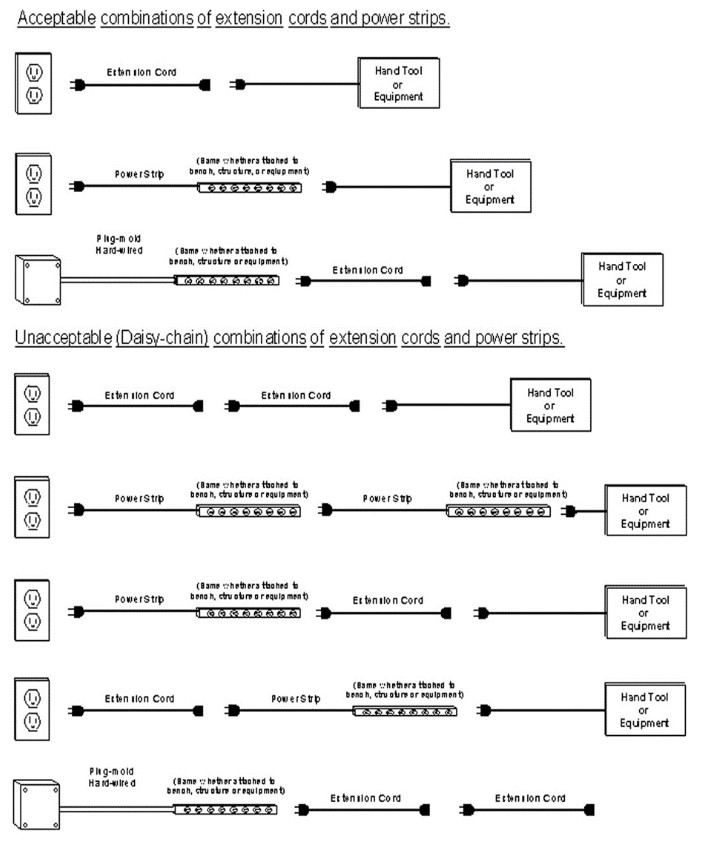
Diagrams of acceptable and unacceptable combinations of extension cords and power strips. Essentially, you are only allowed one intermediate device (extension cord or power strip) between your tool or equipment and your electrical outlet
Examples of Improper Extension Cord Usage
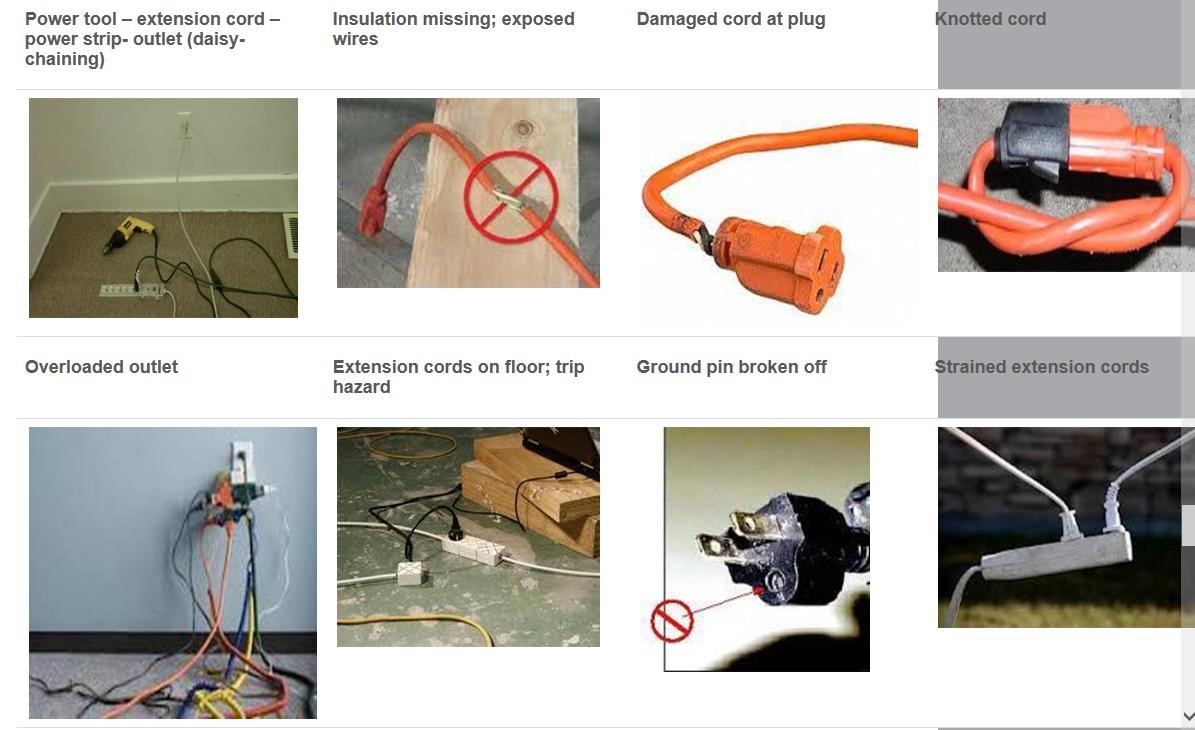

Examples of Proper Extension Cord Usage
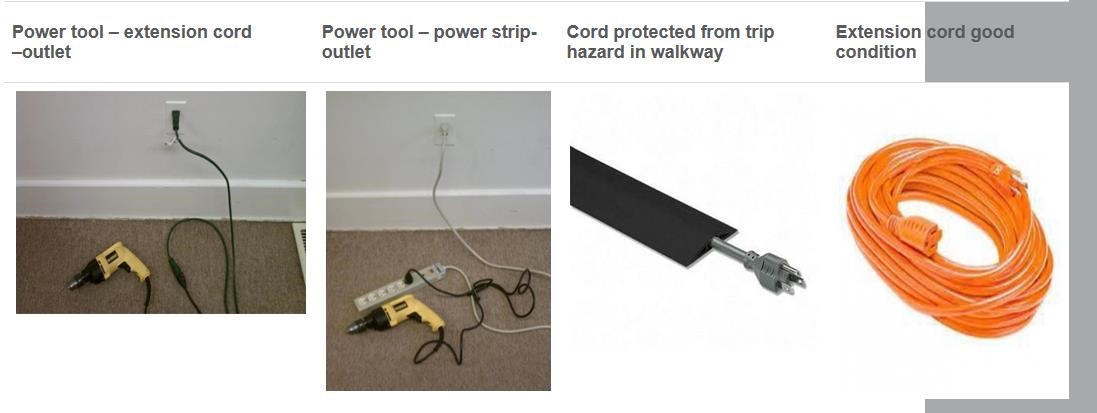
Record Keeping
- The permits for Energized Electrical Work Permit shall be maintained for one year after work has been completed.
- Training documentation will be kept for all affected employees indefinitely.
Training and Information Requirements
- Any employees whose job duties do not bring them close enough to exposed parts of electrical circuits (50 volts or more to the ground) do not need electrical safety training.
- Unqualified persons, including those employees who use power tools, perform services of equipment and machines and/or perform maintenance or repair functions on electrical equipment, and who are close enough to exposed parts of electrical circuits (50 volts or more to the ground), require electrical safety training.
- Training must be performed before the employee is assigned duties involving work around or on electrical systems.
- Retraining will be performed whenever inspections performed by the employee’s supervisor or EHS indicate that an employee does not have the necessary knowledge or skills to safely work on or around electrical systems. Retraining will also be performed when policies or procedures change and/or new equipment or systems are introduced into the work area.
Qualified Persons must be trained in the following:
- Can distinguish exposed energized parts from other parts of electrical equipment.
- Determine the nominal voltage of exposed energized parts
- Know what personal protective equipment to wear and understand flash protection boundaries.
- Approach distances
- Must be trained on the specific equipment they will work with.
- Medical services and first aid and rescue equipment
- Lockout/Tagout
- Understand the specific hazards associated with electrical energy.
- Understand safety related work practices.
- Be familiar with UTKs electrical safety policy.
- Understand the energized electrical work permit system.
References
(OSHA) Electrical Standard (29 CFR 1910) NFPA 70: National Electric Code
NFPA 70B: Electrical Equipment Maintenance
NFPA 70E Standard for Electrical Safety in the Workplace. IEEE: Institute of Electrical and Electronic Engineers
UL: Underwriters Laboratories
